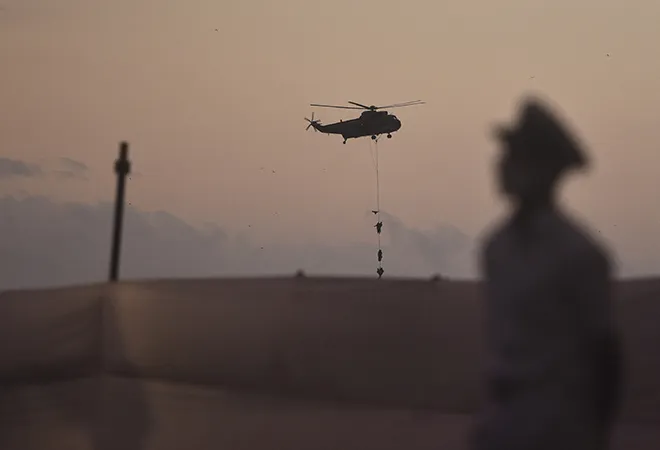
This piece is part of the essay series, Strategic High Tide in the Indo-Pacific: Economics, Ecology, and Security.
The strategic high tide in the Indo-Pacific has been long in the making with many countries working in various permutations and combinations to ensure that a common baseline emerges for cooperation in the region. These efforts are aimed at working towards an equitable rule-based order, where unilateralism does not go unchecked. With China now aggressively raising its stakes for global leadership, the Indo-Pacific continues to be the fulcrum of global geopolitics. As countries, big and small, work to mitigate the fallout of sharpening strategic competition, there is expectation from leading powers in the region to show both political will and demonstrate capability.
What is apparent from the emerging geopolitics in the region are broad trends, namely, a rebalancing of security and economic cooperation with the rise of militarisation, finding avenues for functional cooperation and reimagining of security, especially in the post COVID-19 era in the terms of broader conceptualisation of human security. The development and security agenda of the Indo-Pacific are certainly not mutually exclusive. Most of these efforts are aimed at building habits of cooperation amongst like-minded countries and are developing in parallel tracks.
A focused effort on building capacity of countries in the Indo-Pacific to give them viable alternatives which go beyond binaries formed around ideological and political contestation.
Specifically, three trends have emerged as distinguishable features, which serve as the building blocks of cooperation in the Indo-Pacific today—1) issue-based coalitions driven by function, where flexibility of these configurations remains a strategic asset; 2) like-minded countries working together in overlapping bilateral, minilateral, and plurilateral formats—to expand global initiatives in a way that they are institutionalised within the national agendas of regional like-minded powers; 3)a focused effort on building capacity of countries in the Indo-Pacific to give them viable alternatives which go beyond binaries formed around ideological and political contestation.
It is established now that issue-based coalitions, where function, not form, drive engagement, are gaining traction and have become the arenas of functional cooperation. This has happened as a result of the old global multilateral order failing to manage rising challenges. There is a growing realisation that countries coming together in various formats, across geographies with focused lines of effort—economic, security, tech, strategic—would be more productive than depending on the current fractured and non-delivering instruments of global governance. The flexibility of these groupings is their biggest asset.
The Quadrilateral dialogue and its expanded formats, loosely termed Quad plus, at the peak of the pandemic, coordinating vaccine development, its export and finding ways to boost economic recovery is a good example of these issue-based coalitions. Subsequently, working groups in critical technologies, vaccines, climate change, space, biotech, and 5G—aimed to develop norms and global standards—are a case in point. The Supply Chain Resilience Initiative between India, Japan, and Australia was undertaken to build resilience of supply chains to ensure dependable sources of supply and attract investment. On the sidelines of the COP26 summit, PM Modi emphasised that “trusted sources, transparency and time-frame” are three vital fields that regulate the global supply chain. Pitching India as a trusted source in IT and pharma supply chains, he reiterated India’s willingness to participate in the clean technology supply chain. Untangling supply chains from over-reliance on China has been a painful process but one that is gathering momentum.
There is a growing realisation that countries coming together in various formats, across geographies with focused lines of effort—economic, security, tech, strategic—would be more productive than depending on the current fractured and non-delivering instruments of global governance.
Two, congruence of efforts overlapping in bilateral, minilateral, and plurilateral platforms that then loop into expansion of global initiatives are growing. Like-minded partners are also working at institutionalising these efforts in a way that they are underwritten into national agendas. For example, India has sought to leverage its bilateral relationships to bolster the India-led multilateral platforms—The Indo-Pacific Oceans Initiative and The Global Coalition for Disaster Resilient Infrastructure.
When India tabled the Indo-Pacific Oceans’ Initiative (IPOI) at the East Asia Summit in November 2019, it aimed to invite “practical cooperation as an open, non-treaty-based global initiative” building upon ASEAN-led frameworks. From maritime security to blue economy, its seven pillars cover what New Delhi described “as a lowest common denominator approach to shared problems that we all know require urgent and coordinated solutions”. Australia, Japan, France, and Indonesia have come on board the initiative to find innovative solutions to shared concerns.
Three, as contestation between democratic countries and authoritarian systems sharpen in the primary theatre of the Indo-Pacific, middle powers are looking at building habits of cooperation. The imperative while responding to the threat of a rising and aggressive superpower, looks at going beyond binaries and focusing on capacity building. This gives all nations, big and small, in the region viable alternatives that help them exercise their agency. The new priorities of the post-COVID world—health security and vaccine development, digital delivery, and green growth—all fall in this arena.
For example, since India’s infrastructure diplomacy is also linked with its development assistance programmes in the neighbourhood, new avenues for cooperation are emerging. Avoiding zero-sum game competition in the neighbourhood, India’s has aimed at synergising efforts with like-minded partners to provide viable alternatives for connectivity externally while energising its domestic industry to take the lead as well. India has emerged as a reliable cross-border electricity provider to Nepal and other South Asian partners. It is important to note that the signing of this agreement was a prerequisite for the implementation of the US Millennium Challenge Corporation (MCC) grant to Nepal, which, if implemented, would enable Nepal to receive US $500 million for electricity transmission and road infrastructure projects. MCC is one of the largest US grants in recent history for Nepal for the development of infrastructure. Similarly, India has been invited to join the US-led Build Back Better World Initiative, and experts are examining India’s opportunities to join the Blue Dot Network, which aims to grade infrastructure financing across the Indo-Pacific to ensure transparency and confidence amongst economically weaker countries.
India has led efforts on White Shipping Information Exchange, which has seen participation by several countries.
For India, the evolving geopolitics in the Indo Pacific not just provides collaborative solutions to shared concerns but is also a theatre of opportunity to showcase itself as a leading power in the region that is willing to step up. India is now leading global conversations and initiatives from their inception. A proponent of the “India Way”, the External Affairs Minister S Jaishankar has said, “(The) Indo-Pacific is actually a bread-and-butter expression of our political, economic, connectivity, travel, and societal interests. And relies heavily on ensuring the safety and security of the maritime domain.” The Indian Navy and Coast guard are now, more than before, participating in plurilateral and bilateral exercises, to build confidence, achieve interoperability, and evolve common SOPs. India has led efforts on White Shipping Information Exchange, which has seen participation by several countries. Another example of practical efforts at cooperation would be India assisting countries with Hydrographic survey support for charting of water, especially in the Indian Ocean Region (IOR).
In addition, effectiveness of regional leadership in times of crisis—the COVID-19 outreach in the neighbourhood and globally would be a case in point. From providing solutions like vaccine development and export, reimagining healthcare as a strategic asset and being the first responder and preferred partner in IOR or conceptualising global initiatives in the wider Indo Pacific region with like-minded partners—the efforts showcase India’s ability to rise to the call of burden sharing by global powers.
Whether it’s the Quad format or the debate around the AUKUS, India seems to be working on a broader mandate of human security, where “consensus” grounds collaboration and complementarity. In essence for India, partnerships, preparedness, and the proliferation of a networked region seem to be the way forward.
The views expressed above belong to the author(s). ORF research and analyses now available on Telegram! Click here to access our curated content — blogs, longforms and interviews.




 PREV
PREV


